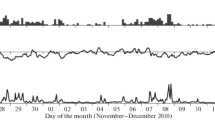Abstract
The results of observations of the total electron content (TEC) in periods of storm disturbances of meteorological situation are presented in the paper. The observational results have shown that a passage of a meteorological storm is accompanied by a substantial decrease in values of TEC and critical frequencies of the ionospheric F2 region. The decreases in values of these ionospheric parameters reach 50% and up to 30% in TEC and critical frequency of the F2 layer, respectively, as compared to meteorologically quiet days. Based on qualitative analysis, it is found that the processes related to formation of local regions of thermospheric heating due to a dissipation of AGW coming into the upper atmosphere from the region of the meteorological disturbance in the lower atmosphere are a possible cause of these ionospheric disturbances.
Similar content being viewed by others
References
Baran, L.W., Shagimuratov, I.I., and Tepenitzina, N.J., The use of GPS for ionospheric studies, Artif. Satell. J. Planet. Geod., 1997, vol. 32, no. 1, pp. 49–60.
Chernigovskaya, M.A., Shpynev, B.G., and Ratovsky, K.G., Meteorological effects of ionospheric disturbances from vertical radio sounding data, J. Atmos. Sol.-Terr. Phys., 2015, vol. 136, pp. 235–243.
Deminov, M.G. and Nepomnyashchaya, E.V., Dependence of the midlatitude F-spread probability on solar and geomagnetic activity, Geomagn. Aeron. (Engl. Transl.), 2003, vol. 43, no. 6, pp. 711–717.
Gavrilov, N. and Kshevetskii, S., Dynamical and thermal effects of nonsteady nonlinear acoustic–gravity waves propagating from tropospheric sources to the upper atmosphere, Adv. Space Res., 2015, vol. 56, no. 9, pp. 1833–1843.
Karpenko, A.L. and Manaenkova, N.I., Nonlinear time series analysis of the ionospheric measurements, Geol. Rundsch., 1996, vol. 85, no. 1, pp. 124–129.
Karpov, I.V. and Kshevetskii, S.P., Formation of large-scale disturbances in the upper atmosphere caused by acoustic gravity wave sources on the Earth’s surface, Geomagn. Aeron. (Engl. Transl.), 2014, vol. 54, no. 4, pp. 513–522.
Karpov, I.V., Borchevkina, O.P., Dadashev, R.Z., and Il’minskaya, A.V., Influence of meteorological storms on ionospheric parameters in the Baltic region in 2010, Soln.–Zemnaya Fiz., 2016a, vol. 2, vol. 2, pp. 64–68.
Karpov, I.V., Kshevetskii, S.P., Borchevkina, O.P., Radievskii, A.V., and Karpov, A.I., Disturbances of the upper atmosphere and ionosphere caused by acoustic–gravity wave sources in the lower atmosphere, Russ. J. Phys. Chem. B, 2016b, vol. 35, no. 1, pp. 1–6.
Kunitsyn, V.E., Suraev, S.N., and Akhmedov, R.R., Modeling of atmospheric propagation of acoustic gravity waves generated by different surface sources, Moscow Univ. Phys. Bull., 2007, vol. 62, no. 2, pp. 122–125.
Laštovička, J., Forcing of the ionosphere by waves from below, J. Atmos. Sol.-Terr. Phys., 2006, vol. 68, nos. 3–5, pp. 479–497.
Polyakova, A.S. and Perevalova, N.P., Comparative analysis of TEC disturbances over tropical cyclone zones in the north-west Pacific Ocean, Adv. Space Res., 2013, vol. 52, pp. 1416–1426.
Sauli, P. and Boška, J., Observations of gravity waves of meteorological origin in the F-region ionosphere, Phys. Chem. Earth., Part C, 2001, vol. 26, no. 6, pp. 425–428.
Sindelarova, T., Buresova, D., Chum, J., and Hruska, F., Doppler observations of infrasonic waves of meteorological origin at ionospheric heights, Adv. Space Res., 2009, vol. 43, no. 11, pp. 1644–1651.
Vadas, S.L. and Fritts, D.C., Thermospheric responses to gravity waves: Influences of increasing viscosity and thermal diffusivity, J. Geophys. Res., 2005, vol. 110, D15103.
Vadas, S.L. and Liu, H., Generation of large-scale gravity waves and neutral winds in the thermosphere from the dissipation of convectively generated gravity waves, J. Geophys. Res., 2009, vol. 114, A10310.
Yiğit E., Aylward, A.D., and Medvedev, A.S., Parameterization of the effects of vertically propagating gravity waves for thermosphere general circulation models: Sensitivity study, J. Geophys. Res., 2008, vol. 113, D19106.
Yiğit E., Knízová, P.K., Georgieva, K., and Ward, W., A review of vertical coupling in the atmosphere–ionosphere system: Effects of waves, sudden stratospheric warmings, space weather, and of solar activity, J. Atmos. Sol.-Terr. Phys., 2016, vol. 141, pp. 1–12.
http://www.rp5.ru.
Author information
Authors and Affiliations
Corresponding author
Additional information
Original Russian Text © O.P. Borchevkina, I.V. Karpov, 2017, published in Geomagnetizm i Aeronomiya, 2017, Vol. 57, No. 5, pp. 670–675.
Rights and permissions
About this article
Cite this article
Borchevkina, O.P., Karpov, I.V. Ionospheric irregularities in periods of meteorological disturbances. Geomagn. Aeron. 57, 624–629 (2017). https://doi.org/10.1134/S0016793217040041
Received:
Accepted:
Published:
Issue Date:
DOI: https://doi.org/10.1134/S0016793217040041




